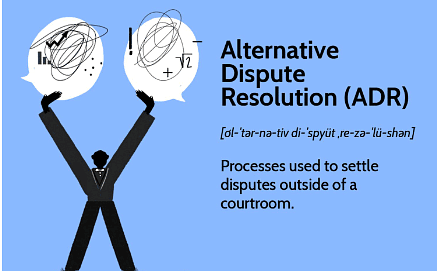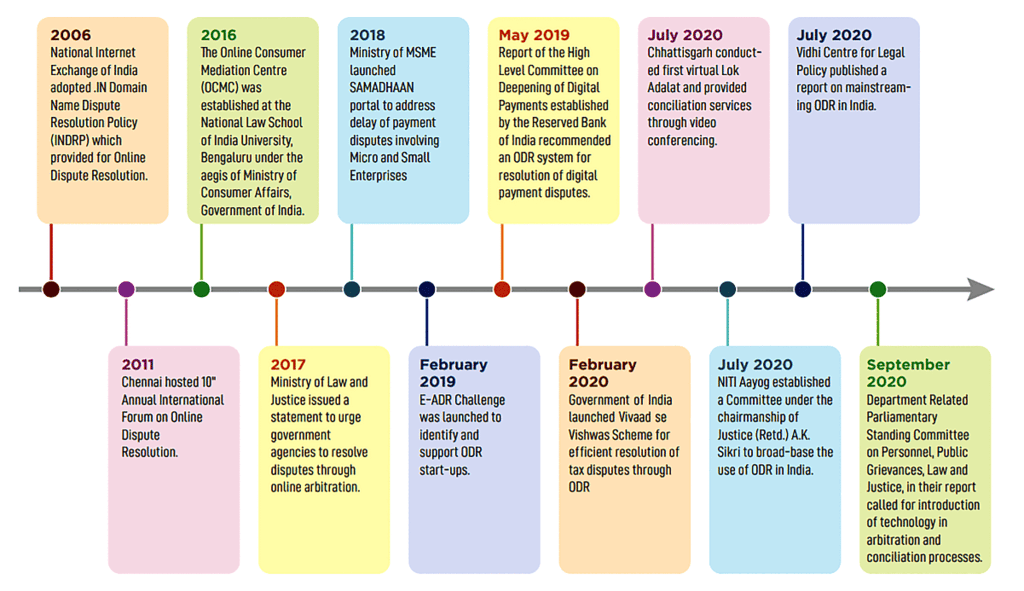UPSC Exam > UPSC Notes > Gist of Rajya Sabha TV / RSTV (now Sansad TV) > In-Depth: Reduction in Pendency of Cases & Arbitration
In-Depth: Reduction in Pendency of Cases & Arbitration | Gist of Rajya Sabha TV / RSTV (now Sansad TV) - UPSC PDF Download
Why in News?
The Indian judiciary is heavily burdened with a backlog of cases, with almost 60,000 cases in the Supreme Court, 4.47 million in various High Courts, and 31.4 million in district and subordinate courts as of November 2019, leading to a growing reliance on Alternative Dispute Resolution (ADR) methodologies.
What is Alternative Dispute Resolution (ADR)?
About:
- Alternative Dispute Resolution (ADR) has been provided under Section 89, Civil Procedure Code (CrPC), 1908 and encompasses a range of approaches to settling disputes outside of conventional court proceedings.
Methods:
- Section 89 of the CrPC allows the court to refer a dispute for settlement through various methods when it seems that a resolution acceptable to the parties may be achievable.
These methods include Arbitration, Mediation and Conciliation.
- Arbitration: It occurs when two or more parties agree that a dispute or potential dispute will be resolved in a legally binding manner by one or more impartial individuals.
- The decision reached through arbitration is called an “award,” which is binding on the parties and can be enforced by the courts. Unlike conciliation and mediation, there is no appeal against the arbitration award.
- Mediation: It is a process where an independent third person helps the disputing parties reach a negotiated resolution.
- This third person, known as the Mediator, facilitates discussions and assists the parties in finding common ground, but does not express opinions on the merits of the dispute. A Mediator does not determine the dispute but assists in the negotiation process.
- Conciliation: Conciliation is a process in which a third party assists the parties in reaching a mutually agreeable resolution to their dispute. The third party, known as the Conciliator, is appointed by mutual consent of both parties.
- Unlike arbitration and court litigation, conciliation is a voluntary and non-binding process.
What is the Need for Alternative Dispute Resolution (ADR) in India?
- Judicial Backlog: Courts in India are overwhelmed with a large number of pending cases, leading to significant delays in delivering justice.
- As of December 2023, around five crore cases were pending in various courts across the country.
- Expensive Litigation: Conventional court litigation is costly, with expenses including court fees, lawyers' fees, and other associated costs such as documentation fees, travel expenses, and administrative costs making it unaffordable for many individuals.
- Lengthy Court Procedures: Court procedures in India are often prolonged and time-consuming, which exacerbates delays in case resolution.
- On average, it takes about four years to dispose of a case in High Courts and around six years in subordinate courts.
- Accessibility: A significant portion of India's population is illiterate and impoverished, finding the court system too technical, lengthy, and expensive.
- ADR offers a simpler, more accessible alternative for these individuals.
- Flexibility and Efficiency: ADR proceedings are flexible, allowing parties to choose the applicable law, conduct proceedings in any agreed-upon manner and language, and settle matters in fewer meetings, thus saving time and expenses.
- Convenience: In ADR, parties can mutually agree on the date, location, and fee for the neutral third party, making the process more convenient.
- Reducing Court Burden: Diverting petty cases to ADR allows courts to focus on more serious matters, particularly those involving heinous crimes.
- Government Expenses: Litigation increases the operational expenses of courts, which are funded by public money.
- Reducing the number of cases through ADR can help decrease these costs.
- Preserving Relationships: Litigation often damages relationships and causes emotional stress. ADR provides a more amicable way to resolve disputes, helping to preserve relationships.
What is India’s Potential to Emerge as an Arbitration Hub?
- Economic Growth: As India's economy expands, the volume of commercial disputes rises proportionately, necessitating robust arbitration mechanisms to resolve these conflicts efficiently.
- Impact of Technology: The COVID-19 pandemic has led to a shift towards virtual arbitration hearings, significantly increasing the efficiency of ongoing integration of technology in arbitration processes.
- Legal Expertise: India boasts a pool of highly skilled lawyers, judges, and arbitrators who are well-versed in arbitration practices, providing a strong foundation for handling complex disputes.
- Legal Reforms: India has modernised its arbitration laws to align with global standards, including adherence to the New York Convention on the recognition and enforcement of foreign arbitral awards, enhancing its credibility as an arbitration-friendly jurisdiction.
- Arbitration Institutions: The country is home to established arbitration centres such as the Indian Council of Arbitration (ICA), the Mumbai Centre for International Arbitration (MCIA), and the Delhi International Arbitration Centre (DIAC), which offer structured and professional environments for dispute resolution.

What are the Various Government Measures to Promote Alternate Dispute Resolution?
- India International Arbitration Centre (IIAC): It was established under the India International Arbitration Centre Act, 2019, to offer premier arbitration services and facilities for both domestic and international disputes.
- Lok Adalats: It was promoted under the Legal Services Authorities (LSA) Act, 1987, to facilitate the amicable settlement of disputes at both the pre-litigation and litigation stages, decisions made by Lok Adalats are binding and equivalent to civil court orders.
Establishment of a Legal Framework:
- Mediation Act, 2023: Authorizes courts to refer disputes to mediation and provides a comprehensive legislative framework for mediation.
- Section 89, Civil Procedure Code, 1908: Recognizes and supports Arbitration, Conciliation, Mediation, and Judicial Settlement, including Lok Adalats, as alternative dispute resolution (ADR) methods.
- Arbitration and Conciliation Act, 1996: Enacted to unify and revise laws related to domestic and international arbitration and the enforcement of foreign arbitral awards.
- Amendments of 2015, 2019, and 2021 encourage speedy, cost-effective, and institutional arbitration while reducing judicial intervention.
- Commercial Courts Act, 2015: This was amended in 2018 to introduce Pre-Institution Mediation and Settlement (PIMS) for certain commercial disputes, requiring mediation before litigation.
Question for In-Depth: Reduction in Pendency of Cases & ArbitrationTry yourself: Which of the following methods of Alternative Dispute Resolution (ADR) involves a binding decision made by an impartial individual?View Solution
What are the Challenges Associated with the ADR?
- Legal and Institutional Barriers: Existing legal frameworks and institutional practices may not fully support or integrate ADR mechanisms.
- For example, the enforceability of mediated agreements can sometimes be unclear or cumbersome, as seen in jurisdictions where mediated settlements require additional legal steps to become binding.
- Lack of Awareness and Acceptance: Many individuals, including legal professionals and the general public, may be unfamiliar with or have misconceptions about the benefits and processes of ADR mechanisms.
- For instance, some may mistakenly believe that ADR lacks the authority of traditional litigation, leading to hesitation in choosing these methods.
- Insufficient Training: ADR professionals, such as mediators, require specialized skills beyond typical legal training.
- Current prerequisites for mediators, such as the need for extensive professional experience, can create barriers to entry, resulting in a shortage of well-trained mediators.
- Lack of Accessibility: Accessibility issues can arise, especially in remote or rural areas, where there may be a lack of available ADR services.
- For instance, in some rural communities, parties might need to travel long distances to access ADR professionals, adding to the overall cost and inconvenience.
What Measures Need to Be Adopted to Promote ADR?
- Strengthening Legal Frameworks: Ensuring that the legal system supports ADR mechanisms through clear laws and regulations includes making mediated agreements easily enforceable and integrating ADR processes more seamlessly into the judicial system.
- The 129th Law Commission report and Malimath Committee have recommended making it mandatory for the courts to refer disputes for resolution through ADR rather than litigation.
- Enhancing Awareness and Education: Implementing awareness campaigns and educational programs to inform both the public and legal professionals about the benefits and processes of ADR.
- Improving Training and Certification: Developing comprehensive training programs for mediators and arbitrators, incorporating techniques like co-mediation and shadow mediation, establishing certification processes and integrating ADR training into degree curriculums to ensure that professionals are well-equipped with the necessary skills and knowledge.
- For instance, the Chartered Institute of Arbitrators (CIArb) offers a widely recognized certification program that includes extensive training and practical assessments.
- Role of Technology: The advancement of Information Technology in the form of AI, big data, Machine Learning and blockchain can be increasingly embedded in legal processes.
- One example where the true potential of technology can be exploited and harnessed in the realm of blockchain-driven arbitration processes for smart contracts.
- Government's Shift to Mediation: With governments at the Union and state levels involved in approximately 40% of litigations, there is a significant opportunity to resolve disputes through ADR, establishing ADR centres, particularly mediation centres, within various government departments can facilitate this shift.
- For example, In India, the Maharashtra Mediation and Conciliation Centre, established in cooperation with the state government, aims to resolve disputes involving government departments.
The document In-Depth: Reduction in Pendency of Cases & Arbitration | Gist of Rajya Sabha TV / RSTV (now Sansad TV) - UPSC is a part of the UPSC Course Gist of Rajya Sabha TV / RSTV (now Sansad TV).
All you need of UPSC at this link: UPSC
FAQs on In-Depth: Reduction in Pendency of Cases & Arbitration - Gist of Rajya Sabha TV / RSTV (now Sansad TV) - UPSC
| 1. What is the significance of Alternative Dispute Resolution (ADR) in India? |  |
Ans. ADR in India is essential as it offers a quicker, cost-effective, and less adversarial way to resolve disputes outside of traditional court proceedings.
| 2. How can India potentially become an arbitration hub? |  |
Ans. India has the potential to emerge as an arbitration hub due to its strategic location, skilled legal professionals, supportive judiciary, and recent reforms in arbitration laws.
| 3. What government measures are in place to promote Alternative Dispute Resolution in India? |  |
Ans. The Indian government has introduced various initiatives such as the Arbitration and Conciliation (Amendment) Act, 2019, promoting mediation, and setting up specialized ADR centers to encourage the use of ADR methods.
| 4. What are some challenges associated with Alternative Dispute Resolution in India? |  |
Ans. Challenges include lack of awareness about ADR methods, reluctance to move away from traditional litigation, enforcement issues, and a shortage of skilled mediators and arbitrators.
| 5. What measures need to be adopted to promote ADR in India? |  |
Ans. To promote ADR in India, measures such as increasing awareness through education and training programs, incentivizing parties to opt for ADR, improving infrastructure for ADR proceedings, and enhancing the enforcement of ADR awards are essential.
Related Searches
















